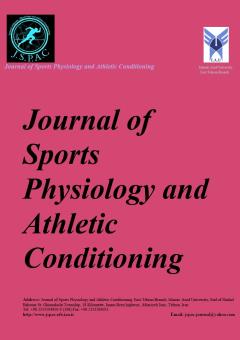The effect of endurance training and probiotic consumption on IL-18 gene expression in male rats with steatosis
Subject Areas : Sport PhysiologyValiollah Shahedi 1 , Naghmeh Tourani 2 , Ayub Kobari 3
1 - Assistant Professor, Department of Physical Education & Sport Sciences, Faculty of Humanities, Parand Branch, Islamic Azad University, Parand, Tehran, Iran.
2 -
3 - Department of Physical Education & Sport Sciences, Faculty of Humanities, Parand Branch, Islamic Azad University, Parand, Tehran, Iran
Keywords: Steatosis, Probiotic, IL-18, Endurance Training,
Abstract :
Background: Fatty liver disease is the most important reason for chronic liver diseases such as liver fibrosis, cirrhosis and liver cancer. The aim of this study was the effect of endurance training and probiotic consumption on IL-18 gene expression in male rats with steatosis. Materials and Methods: In this experimental study, 32 rats (average weight 200-250 grams) were randomly divided into four groups (healthy control, modeled (steatosis) group, steatosis + probiotic group, and steatosis + probiotic + exercise group). Training groups for 8 weeks, 5 sessions every week, in the beginning week with a speed of 18 meters per minute, time of 10 minutes, and every week the speed of 1-2 meters per minute and the time was increased by 10 minutes, so that In the fourth week, the speed reached 22 meters per minute and the time reached 40 minutes. The groups receiving the supplement received 109 CFU/ml of Lactobacillus rhamnus GG by gavage daily for 8 weeks and 5 days a week. IL-18 gene expression in liver tissue was measured by Real-time PCR method. The data were evaluated using the statistical method of one-way analysis of variance and significance level (P ≥ 0.05). Results: The results showed that endurance training along with probiotic consumption significantly decreased IL-18 gene expression in rats with steatosis. Conclusion: It seems that performing endurance training along with probiotic consumption can have a greater effect than the effect of probiotic alone on IL-18 gene expression.
1. Malhi H, Gores GJ. Cellular and molecular mechanisms of liver injury. Gastroenterology. 2008 May;134(6):1641-54. doi: 10.1053/j.gastro.2008.03.002. PMID: 18471544; PMCID: PMC2553363.
2. Arabzadeh E, Shirvani H, Ebadi Zahmatkesh M, Riyahi Malayeri S, Meftahi GH, Rostamkhani F. Irisin/FNDC5 influences myogenic markers on skeletal muscle following high and moderate-intensity exercise training in STZ-diabetic rats. 3 Biotech. 2022 Sep;12(9):193. doi: 10.1007/s13205-022-03253-9. Epub 2022 Jul 26. PMID: 35910290; PMCID: PMC9325938.
3. Dowman JK, Tomlinson JW, Newsome PN. Pathogenesis of non-alcoholic fatty liver disease. QJM. 2010 Feb;103(2):71-83. doi: 10.1093/qjmed/hcp158. Epub 2009 Nov 13. PMID: 19914930; PMCID: PMC2810391.
4. Riyahi Malayeri S, Kaka Abdullah Shirazi S, Behdari R, mousavi Sadati K. Effect of 8-week Swimming training and garlic intake on serum ICAM and VCAM adhesion molecules in male obese rats. JSSU 2019; 26 (10) :867-878. URL: http://jssu.ssu.ac.ir/article-1-4695-en.html.
5. Moroti C, Souza Magri LF, de Rezende Costa M, Cavallini DC, Sivieri K. Effect of the consumption of a new symbiotic shake on glycemia and cholesterol levels in elderly people with type 2 diabetes mellitus. Lipids Health Dis. 2012 Feb 22;11:29. doi: 10.1186/1476-511X-11-29. PMID: 22356933; PMCID: PMC3305430.
6. Riyahi Malayeri, S., Mirakhorli, M. The Effect of 8 Weeks of Moderate Intensity Interval Training on Omentin Levels and Insulin Resistance Index in Obese Adolescent Girls. Sport Physiology & Management Investigations, 2018; 10(2): 59-68. https://www.sportrc.ir/article_67070.html?lang=en.
7.Wang Z, Gao ZM, Huang HB, Sun LS, Sun AQ, Li K. Association of IL-8 gene promoter− 251 A/T and IL-18 gene promoter− 137 G/C polymorphisms with head and neck cancer risk: a comprehensive meta-analysis. Cancer management and research. 2018 Aug 10:2589-604. https://www.tandfonline.com/doi/full/10.2147/CMAR.S165631.
8. Bonyadi F, Tukmechi A, Mohebalian H. An overview of probiotics and their role in cancer management. J Mazandaran Univ Med Sci 2014; 24 (112) :128-140
URL: http://jmums.mazums.ac.ir/article-1-3122-en.html
9. West NP, Pyne DB, Cripps AW, Christophersen CT, Conlon MA, Fricker PA. Gut Balance, a synbiotic supplement, increases fecal Lactobacillus paracasei but has little effect on immunity in healthy physically active individuals. Gut Microbes. 2012 May-Jun;3(3):221-7. doi: 10.4161/gmic.19579. Epub 2012 May 1. PMID: 22572834; PMCID: PMC3427214.
10. Hosseini M, Ghasem Zadeh Khorasani N, Divkan B, Riyahi Malayeri S. Interactive Effect of High Intensity Interval Training with Vitamin E Consumption on the Serum Levels of Hsp70 and SOD in Male Wistar Rats. Iranian J Nutr Sci Food Technol 2019; 13 (4) :21-28. URL: http://nsft.sbmu.ac.ir/article-1-2689-en.html.
11. Roberfroid M. Prebiotics: the concept revisited. J Nutr. 2007 Mar;137(3 Suppl 2):830S-7S. doi: 10.1093/jn/137.3.830S. PMID: 17311983.
12. Thomas CM, Versalovic J. Probiotics-host communication: Modulation of signaling pathways in the intestine. Gut Microbes. 2010 May-Jun;1(3):148-63. doi: 10.4161/gmic.1.3.11712. PMID: 20672012; PMCID: PMC2909492.
13. Mozaffari Namin B, Daryani NE, Mirshafiey A, Yazdi MKS, Dallal MMS. Effect of probiotics on the expression of Barrett's oesophagus biomarkers. J Med Microbiol. 2015 Apr;64(Pt 4):348-354. doi: 10.1099/jmm.0.000039. Epub 2015 Feb 9. PMID: 25666837.
14. Dargahi N, Johnson JC, Apostolopoulos V. Immune modulatory effects of probiotic Streptococcus thermophilus on human monocytes. Biologics. 2021 Nov 19;1(3):396-415. doi: https://doi.org/10.1101/2020.08.27.271346
15. Zirlik A, Abdullah SM, Gerdes N, MacFarlane L, Schönbeck U, Khera A, McGuire DK, Vega GL, Grundy S, Libby P, de Lemos JA. Interleukin-18, the metabolic syndrome, and subclinical atherosclerosis: results from the Dallas Heart Study. Arterioscler Thromb Vasc Biol. 2007 Sep;27(9):2043-9. doi: 10.1161/ATVBAHA.107.149484. Epub 2007 Jul 12. PMID: 17626902.
16. Colbert LH, Visser M, Simonsick EM, Tracy RP, Newman AB, Kritchevsky SB, Pahor M, Taaffe DR, Brach J, Rubin S, Harris TB. Physical activity, exercise, and inflammatory markers in older adults: findings from the Health, Aging and Body Composition Study. J Am Geriatr Soc. 2004 Jul;52(7):1098-104. doi: 10.1111/j.1532-5415.2004.52307.x. PMID: 15209647.
17. Bruun JM, Stallknecht B, Helge JW, Richelsen B. Interleukin-18 in plasma and adipose tissue: effects of obesity, insulin resistance, and weight loss. Eur J Endocrinol. 2007 Oct;157(4):465-71. doi: 10.1530/EJE-07-0206. PMID: 17893261.
18. Lam V, Su J, Koprowski S, Hsu A, Tweddell JS, Rafiee P, Gross GJ, Salzman NH, Baker JE. Intestinal microbiota determine severity of myocardial infarction in rats. FASEB J. 2012 Apr;26(4):1727-35. doi: 10.1096/fj.11-197921. Epub 2012 Jan 12. PMID: 22247331; PMCID: PMC3316900.


